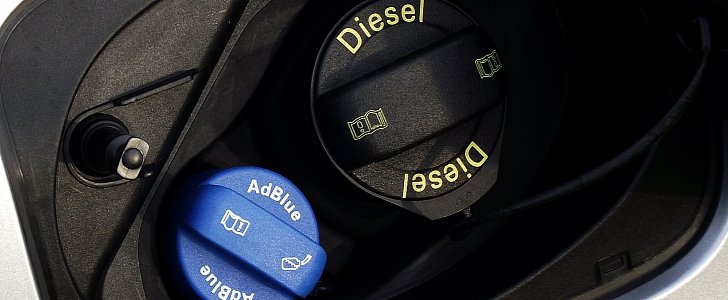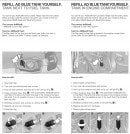Both names are correct and refer to the same kind of product, but people started calling the liquid AdBlue, and the name stuck.
AdBlue is a consumable for diesel-engined vehicles worldwide, and is injected into the SCR catalyst to break down soot and unburnt fuel into water and nitrogen. Both elements are harmless once they exit the exhaust system of the vehicles that generated them.
The liquid is 32.5% urea and 67.5 deionized water. The latter works as a solvent to ensure the solid urea (colorless crystals) becomes a liquid solution. AdBlue is not toxic and is odorless, but it does make a mess if you spill it. However, it can corrode some metals, and it must be stored and transported with care. If you get any AdBlue on your skin, rinse thoroughly.
Keep in mind that all vehicles equiped with this exhaust technology have an urea concentration sensor, so you should never try to dilute the AdBlue or use other liquids.
Friendly warning: You should never use urine either, despite its concentration of urea.
Without AdBlue, most modern diesel-engined vehicles will refuse to start, or will work in a low-power regime called “limp mode.” As an operator of a diesel-engined vehicle, you must monitor the AdBlue level and refill it if necessary.
AdBlue consumption varies depending on the particular after-treatment system of the exhaust gasses, but also on driving style and driving conditions. A vehicle that is being driven hard or a car that’s only in start-stop traffic conditions might have a higher AdBlue consumption than one that gets a good mix of city and highway miles. The latter will still use up its AdBlue, but not as fast as the vehicle driven in hard conditions. We must note that driving “like an old lady” will still use AdBlue, so there’s no evading the need for this fluid.
Normal AdBlue consumption would be ~ 1 liter (0.26 gallons) at 1,200 Km (750 miles). That is not so much for something that prevents these engines to puff out black smoke, isn’t it?
Once your vehicle notifies you that you must refill your AdBlue tank, it is time to go online to get the best price for the particular liquid. While your manufacturer will gladly sell you the needed quantity of AdBlue and will refill it for you, there’s still a possibility of a much cheaper self-servicing option.
We are talking about refilling the installation on your own. If you are comfortable following instructions and doing minimal work, but with a high degree of caution, you are probably prepared to refill your AdBlue tank by yourself.
Unless you use something else instead of the actual AdBlue solution, or if you spill the stuff on your car in a visible manner, there’s no reason to void your warranty because you’ve refilled your AdBlue tank. However, you must be careful when refilling, as to prevent spills.
Some vehicles notify you of the capacity of your AdBlue container. If you do not know how much AdBlue you need for your car, you will have to look it up online or in the user manual. Once you figure out how much AdBlue you need, look for the refill procedure specific to your vehicle.
While some cars have their AdBlue refill cap right next to the Diesel filler cap, others have a different position for it. For some BMWs, it is under the hood, while other cars have a refill cap inside the trunk. Either way, find it before you open the AdBlue container.
Only vehicles with AdBlue technology need AdBlue and those have a special refill cap for the substance. Never refill the AdBlue tank with anything other than AdBlue and never try to dilute the substance.
We cannot stress the importance of not pouring AdBlue in the fuel tank or any other fluid instead of AdBlue in the dedicated tank for the substance. Please, don’t do this, as it will severely damage your vehicle.
Unless you refill with the manufacturer-designed containers, a funnel will be necessary for the top-up with AdBlue. The secret is that some vehicles have a special AdBlue filler nozzle to prevent spills. If your car has one of these, you might need to get a refill bottle from your vehicle manufacturer, along with a few extra liters of AdBlue from an independent brand.
The trick is that you can modify the anti-spill refill bottle sold by the manufacturer of the vehicle to use as a funnel. Once you do this, you can refill your AdBlue on your own without any troubles. Some gas stations in some countries do offer AdBlue at the pump, but these stations are rare and usually target truck drivers, who require serious amounts of AdBlue.
Commercially available AdBlue also comes in big, 10-liter (2,6 gallons) barrels. However, your car might not need that much, and the product has a short shelf life. Therefore, it is recommended only to buy as much AdBlue as you need to refill, and to avoid storing the excess amount.
These 10-liter canisters are useless to the average consumer without a funnel and another clean container, because handling a large container and a tube at the same time would be difficult without any spills. If you have no other option than to purchase a 10-liter bottle of AdBlue, feel free to share the rest with a friend in need. Don’t store the fluid, as the substance loses purity once it meets air and becomes useless or damaging to your emission control system.
Mercedes-Benz AdBlue Technology explained, includes refill procedure
How AdBlue works - explained by PSA Peugeot-Citroen







